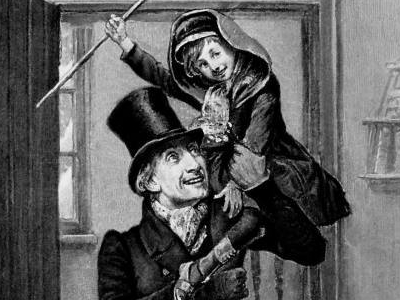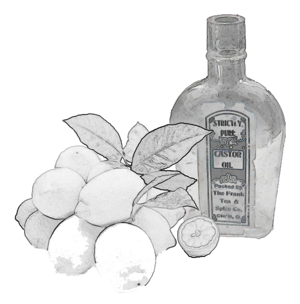
Other than Ebenezer Scrooge in Dickens’s story “A Christmas Carol,” Tiny Tim is certainly the most memorable character. Dickens used the boy in the story to soften the hearts of both Scrooge and his readers toward the worthy poor. Although Victorian sentiments questioned the thrift or industry of the masses, a crippled, saintly child was obviously above reproach.
In Dickens’s day, the disabled were feared because people believed they could be contagious. In “A Christmas Carol” Dickens personified Tiny Tim as pure virtue and mildness to create an inspirational character in spite of his disability. People with disabilities today want characters who are fully human with stories and imperfections of their own rather than saintly depictions intended to teach others a lesson.
We know that Dickens patterned most of his characters after real people. He took many of his personal fears and affectionate feelings for family from his own life when he created the character of Ebenezer Scrooge. The name Tiny Tim was taken from Dickens’s youngest brother, known in the family as Tiny Fred. Dickens chose the name Fred for Ebenezer’s nephew in the story. Dickens named Ebenezer’s beloved late sister Fanny after his real-life sister.
But it was Fanny Dickens’s son who appears to be the inspiration for Tiny Tim’s illness. Fanny married Henry Burnett, and their son, Henry Jr., nicknamed Harry, was crippled from birth. Dickens’s famous story was published on December 17, 1843. Fanny died in 1848 from consumption in her late 30s, and Harry died a year later at age 9.
Dickens was a careful reporter long before he became England’s most well-known novelist. He visited prisons, workhouses and morgues listening to stories and gathering bits of human interest for his writing. Dickens may not have known what was supposed to be wrong with Tiny Tim. But given the careful descriptions he’s given us in the story, physicians have reconstructed a short list of possibilities. Let’s look at the available forensic evidence for what might have ailed young Timothy Cratchit.
Tim is described as tiny. So he had stunted growth. He used a little crutch and often needed to be carried on his father’s shoulder. One leg was not working properly. We are also told his limbs were supported by an iron frame. And when his father holds the boy’s hand, it is described as withered.
Tiny Tim has been used as the poster child for a gamut of issues from urban planning to universal health care. Regardless of the worthiness of these causes, it is interesting to view young Timothy’s case as an object lesson unto itself.
The fact that Timothy has iron leg braces shows he had already received some of the best medical care of his day. Unfortunately, the best chance of benefiting from Victorian medical care was fortuitous quackery. During Dickens’s time, hundreds of cure-all formulas were sold on street corners, and newspaper advertisements most commonly touted alcohol or opiates. If Tiny Tim is a poster child for anything, it is the failure of the best medical attention of the day to alleviate suffering.
Modern forensic medical sleuths have set their minds to the task of retrospectively diagnosing young Timothy and have come up with two possibilities: renal tubular acidosis (RTA) or rickets. RTA, a type of kidney disease that causes excess acids, affects bone production and causes stunted growth. Tim would have grown weaker and may have needed a crutch. The tonics of the day would have contained acids and other toxins that would have exacerbated his kidney failure. Untreated he would have died. Many of the treatments of the day would have killed him more quickly. But the effective treatment is as simple as eating more alkaline-containing foods such as fresh fruits and vegetables.
Although acidic, citrus fruits such as lemons and limes have an alkaline effect in the body and would have been an excellent treatment for RTA. The benefits of limes in preventing scurvy in sailors had been discovered 100 years earlier by James Lind. It was popularized in slang by referring to British sailors as limeys.
Remember that Dickens tells us young Timothy did not die because Ebenezer Scrooge became a second father to him. Doctors had had their chance and failed. The cure must have related to Scrooge’s loving involvement and knowledge. And we are told that Scrooge believed in the importance of diet to cure disease.
The night the ghosts visit, we are told that Scrooge is eating gruel because he suffers from a head cold. Gruel was a common folk remedy of the day for a cold. It is also alkaline forming in the body. Most likely Scrooge would have suggested a dietary treatment for young Cratchit as well.
A second possibility is that Timothy suffered from rickets, which is caused by a vitamin D deficiency. Without it, children don’t build healthy bones and their legs can bow. Vitamin D is found in milk and can also be absorbed via exposure to sunlight. But London is usually overcast. And Victorian Camden Town where the Cratchits live would have been blanketed by smoke.
The evidence against rickets is that it is not usually fatal. And normally if one family member suffers, others would as well. But perhaps the growing family’s economizing with the addition of Tiny Tim removed milk from their diet. And although rickets is usually not directly fatal, children weakened by it often succumb to other childhood ailments.
Rickets is also easily treatable. Castor oil and cod liver oil, both common remedies of the day, are extremely high in vitamin D. Dickens mentions both positively in his writings. One tablespoon of cod liver oil contains 338% of the daily recommended value of vitamin D.
It is easy to imagine the reformed Ebenezer advising Bob Cratchit, “Limes and cod liver oil! What one doesn’t cure the other will.”

Young Timothy Cratchit should remind us how powerful it is when one person takes the time to really care about another person. The concern of small business owners about the well-being of their employees or, better yet, friends supporting each other can succeed even where government policy and medical advice have failed.
Things really aren’t that different today. The personal touch still matters more than public policy. May all of us keep Christmas well. God bless.